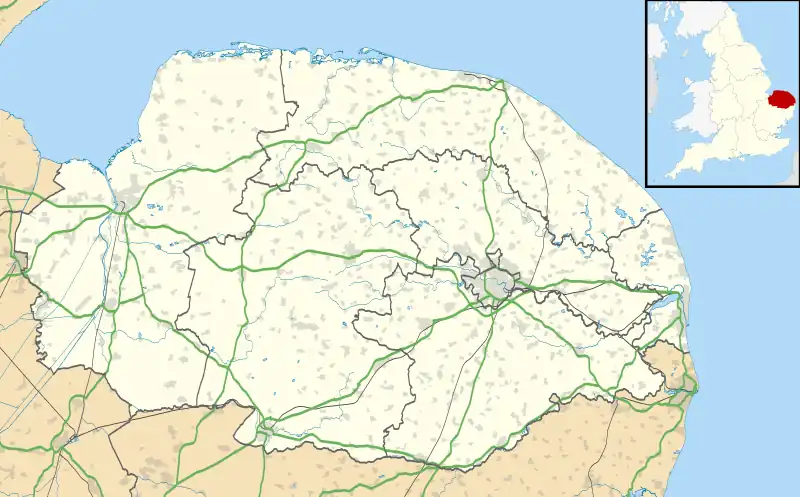Rainthorpe Hall
Rainthorpe Hall is a Grade I listed[1] Elizabethan country mansion near Tasburgh in Norfolk, England, about 8 miles (13 km) south of Norwich.[3] It is notable for its medieval stonework, wood carvings, rare 17th-century leather wall-coverings[1] and 19th-century Victorian mirrors.[4] The hall's grounds extend to 18.7 acres.[3]
| Rainthorpe Hall | |
|---|---|
 The front elevation of Rainthorpe Hall | |
 Location within Norfolk | |
| General information | |
| Type | Private house; stately home |
| Architectural style | Tudor |
| Coordinates | 52.527851°N 1.245525°E |
Listed Building – Grade I | |
| Official name | Rainthorpe Hall including garden wall with gate and gatepiers |
| Designated | 2 October 1951 |
| Reference no. | 1050699[1] |
| Official name | Rainthorpe Hall |
| Designated | 18 September 1987 |
| Reference no. | 1000292[2] |
| Grade | II |
History of Rainthorpe Hall
The settlement of Rainthorpe (Rainestorp) is first recorded in the Doomsday Book under the tenancy of Roger de Rames. It was then a hamlet with a population of 9 households.[5]
There is evidence that the Hall dates back to the 15th century or earlier in some form and that most of the original structure was destroyed by a fire around 1500.[6] In 1579, the lawyer Thomas Baxter purchased the property and set about adding to it and altering it to include two new wings to form the E-shape characteristic of Elizabethan houses of this type, before selling the property in 1628.[7]
There is evidence that Civil War soldiers of the Parliamentary armies were billeted at Rainthorpe, thanks to a carving on the right hand stone pillar of the porch. The initials and date 'R.M. 1641' are inscribed with great care into the stone. It is likely that the stone-floored hall beyond was used for stabling their horses. 1641 was the year before the formation of Cromwell's 'New Model Army' and R.M. is likely to have been a member of the local militia. A relic of the Middle Ages is the nuttery, parallel to the east wall of the garden, coppiced stools of hazel, which, cut on a regular 7 year rota, would provide fencing stakes, tool handles, kindling and other small necessities.
The next owner of note was Frederick Walpole, youngest son of Horatio Walpole, 3rd Earl of Orford, who purchased the property in 1852; his influence on the house can be seen in the hall chimney, stone windows and stained glass.[7]
Colonel Sir Charles Harvey, who later became the 2nd Baronet Harvey of Crown Point, Trowse, Norfolk, bought Rainthorpe Hall in 1878,[7] and the following year constructed the stable block and the castellated gardener's cottage which sits to the right of the property.[8] Harvey added the five bay window extension at the front in 1885.[7]
After this, Rainthorpe Hall was purchased by American paper heiress Rosemary Crane Hastings and her British husband the architectural historian J Maurice Hastings,[9] who, according to his good friend, Maurice Bowra, held "wild parties" at the Hall.[10] The Hall was subsequently inherited by his son, George Hastings,[11] who died in 1992. His children sold it to the barrister and businessman Alastair Wilson QC in 1993.[3][12]
References
- Historic England. "Rainthorpe Hall (Grade I) (1050699)". National Heritage List for England. Retrieved 2 May 2019.
- Historic England. "Rainthorpe Hall (Grade II) (1000292)". National Heritage List for England. Retrieved 2 May 2019.
- "9 bedroom equestrian facility for sale". RightMove. Retrieved 13 November 2013.
- Kirkwood, Holly. "Elizabethan Country house in Norfolk". Country Life. Retrieved 13 November 2013.
- https://opendomesday.org/place/TM2097/rainthorpe/
- Sykes, Christopher Simon (1998). Ancient English Houses: 1240–1612. Chatto and Windus. p. 182. ISBN 9780701131760.
- Gurney, Daniel (1858). The record of the house of Gournay. Oxford University. p. 598. ISBN 0300096577.
- "Rainthorpe Hall". Country Life. 186: 41. 1992.
- Bence-Jones, Mark (1981). Burke's and Savills Guide to Country Houses, Volume 3. Burke's Peerage. p. 170. ISBN 9780850110357.
- Bowra, Cecil Maurice (1966). Memories 1898–1939. Weidenfeld & Nicolson. p. 210.
- "Title Information – Rainthorpe Hall". Norfolk County Council. Retrieved 13 November 2013.
- Churchill, Penny (26 April 2012). "Country properties in Norfolk". Country Life. Retrieved 13 November 2013.